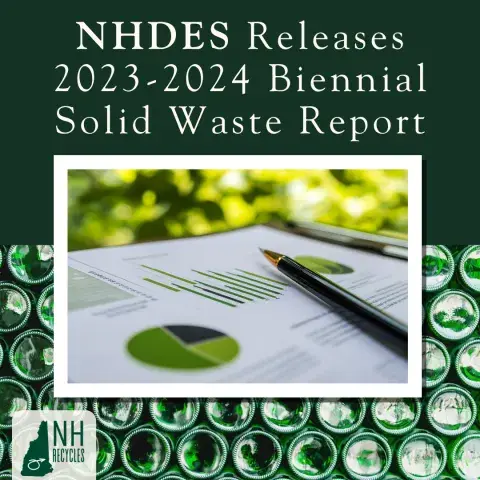
Last month, the NH Department of Environmental Services (NHDES) published its 2023–2024 Biennial Solid Waste Report, highlighting the state’s progress toward reducing disposal of municipal solid waste (MSW) and construction and demolition debris (C&D) by 25% by 2030 and by 45% by 2050, compared to 2018 levels.
The report also details NHDES’s ongoing solid waste management activities and recent legislative updates related to waste reduction and recycling.
Disposal and Waste Trends
The report notes that the percentage of in-state material disposed in NH landfills and the state’s single waste-to-energy plant has steadily increased in recent years. In-state material accounted for 57% of total disposal in 2022, 62% in 2023, and 61% in 2024, a notable shift from historical averages closer to 50%. This change responds in part to public concern over the volume of out-of-state waste entering New Hampshire.
At the same time, NH residents are throwing away a little less. The average amount disposed per person dropped from 0.79 tons in 2022 to 0.75 in 2024.
Progress Toward the State’s Reduction Goal
Since 2018, total disposal of MSW and C&D has shown an encouraging downward trend. After a brief uptick in 2019, New Hampshire has seen consistent decreases in disposal tonnage. By 2024, the combined disposal of MSW and C&D was 13.2% lower than in 2018, marking steady progress toward the state’s 2030 and 2050 goals.
| Year | Total Tons MSW & C&D Disposed | % Change vs. 2018 |
|---|---|---|
| 2019 | 1,535,379 | +2.3% |
| 2020 | 1,446,526 | –3.6% |
| 2021 | 1,494,187 | –0.4% |
| 2022 | 1,394,903 | –7.0% |
| 2023 | 1,313,247 | –12.5% |
| 2024 | 1,302,548 | –13.2% |
Recycling and Diversion
The state’s estimated recycling rate remains low, with 2024’s rate calculated at 16.7%—down from 20.8% in 2020. This decline reflects both lower recycling activity and a change in NHDES’s calculation methodology, which now uses municipal transfer station data as a proxy for statewide recycling activity. NHDES notes that while this approach helps avoid double-counting, it likely underrepresents commercial and institutional recycling not reported by municipalities.
Legislative and Program Updates
The biennial report also reviews significant solid waste–related legislation enacted in recent years, including:
- Food Waste Disposal Ban: Effective in February 2025, this ban requires generators of 1+ tons of food waste per week to divert material for donation, composting, or anaerobic digestion when facilities are available within 20 miles.
- Lithium-Ion Battery Disposal Ban: Effective July 2025, this ban prohibits disposal of rechargeable lithium-ion batteries in landfills or incinerators, reducing the risk of fires at solid waste facilities.
NHDES also highlighted several ongoing initiatives, such as its Solid Waste Infrastructure for Recycling (SWIFR) grant projects, which include New Hampshire’s first statewide waste characterization study and a food waste generator and infrastructure analysis. The Bureau also collaborated with NH Recycles to host a two-day food waste workshop and launched the new Managing My Waste webpage, a resource for residents to learn how to properly dispose of common waste items.
Looking Ahead
Overall, the report shows incremental but meaningful progress in reducing the amount of waste New Hampshire disposes, while highlighting continued challenges in increasing recycling and diversion. NHDES concludes that meeting the state’s 2030 and 2050 reduction goals will require expanded infrastructure, education, and voluntary participation across public and private sectors.
The full 2023–2024 Biennial Solid Waste Report is available on the NHDES website at www.des.nh.gov/waste/solid-waste.
